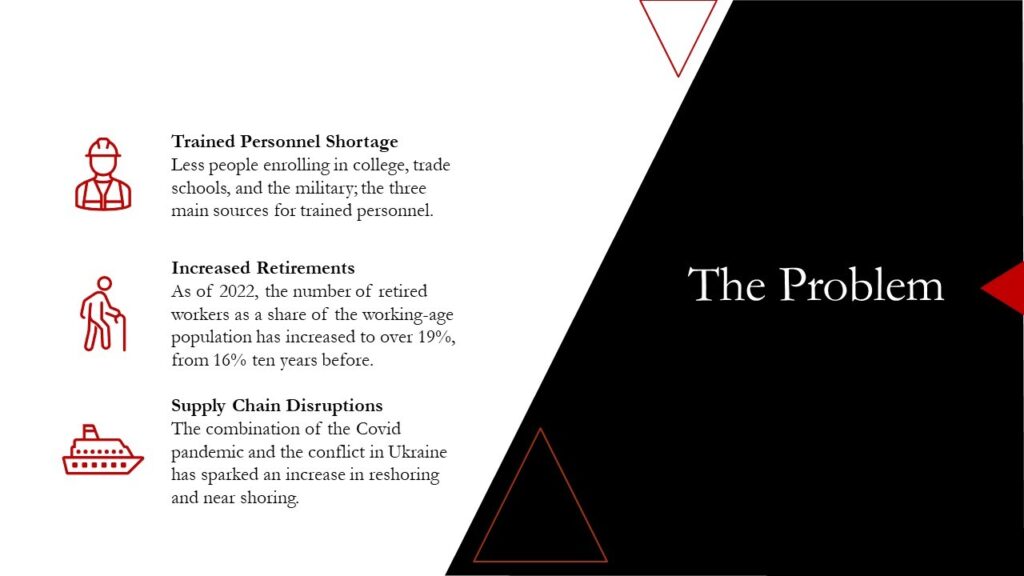From the pandemic to the Great Resignation and remote working, to economic and geopolitical uncertainty, the issues that have beset organizations in recent times are going nowhere in 2023. Yet, as we head into Q2, none should be manufacturers’ top priority. Instead, they must focus on addressing a talent challenge unlike anything we’ve seen in the past.
The numbers are stark. Data from a September AARP bulletin suggests that more than 10,000 workers reach retirement age every day, and as a new wave of younger employees replaces them, it’s creating a huge shift in workforce dynamics. According to Microsoft’s +1.7% 2022 Work Trend Index, 63% of frontline workers are excited about the job opportunities technology creates, while 53% of employees are more likely to prioritize health and wellbeing over work than they were pre-pandemic.
At the same time, a ManpowerGroup survey found that 69% of employers globally say they’re struggling to find staff with the right blend of soft and hard skills to fill critical roles in their businesses, while a recent survey led by The Manufacturing Institute found the skills gap could result in 2.1 million unfilled manufacturing jobs in the US by 2030, potentially costing the industry up to $1 trillion.
Supply chains, which have been tested to their limits in the last few years, will need to continue to increase their flexibility in 2023.
Covid-19 took us by surprise in 2020. Overnight, offices and businesses were shuttered, and supply lines collapsed. We adapted by working from home, limiting socialization, and lowering expectations on the resiliency and flexibility of “just-in-time” supply chains.
But the pandemic is slowly fading in the rearview mirror as a cause of supply-chain disruptions, and other factors that surfaced this year are likely to take its place in 2023. These include war, extreme weather, the threat of a global recession, and politics.

Many private equity funds hear the words “interim executive” and think the only application is turnaround or short-term fill-in. But for PE funds seeking a great return, they look to interims for their unique abilities to build and transform companies.
Here are six major use cases for interim executives in PE-owned portfolio companies:
Interim Executives in Diligence
Most funds hope to spread their wings – work beyond industries where they’ve already had success, by looking at new industries where acquisitions may cost less and produce higher returns. The further afield they go, the more they need expert leadership removed from prior operating teams. While diligence work is not the strict definition of interim, which involves operating roles with decision making authority, many interim executives are happy to help for nominal fees in order to help both investor and seller come to a good transaction if circumstances warrant. The primary goal for the interim is usually to assume a leadership role post-closing.
Interim Executives in Process Improvement and Upgrade Mode
When a professional fund acquires a company, it’s not uncommon for the company to lack process and timely reporting at a standard required by PE funds. Maybe it was a family business, or a private company that could live with lots of informality, but the new owners will start to make upgrades as needed. Many funds report that at the very least, they will deploy a CFO or bring in a new senior financial manager when acquiring a company to establish a higher standard of accounting, financial controls and reporting. In other cases, it’s technology and operations that get an overhaul. ERP implementation. Outsourcing. Supply chain optimization. Funds will look to interims to come in on a project basis, or in some cases come alongside legacy management to raise the bar.
Interim Executives in Closing Mode
While a permanent search can take upwards of six months, no one wants to see a transaction slowed for lack of one key role – hence the efficacious use of interims – strong leaders to help close the deal, establish better systems and controls, and help recruit any new permanent executives. A good interim will put in place a plan, systems and processes that can be handed off seamlessly.
Interim Executives in Growth Mode
While most interim engagements run 18 – 24 months, it’s not uncommon to hear that an interim CEO has made the decision to match their tenure to that of a PE fund’s goals, especially if the fund sees a possible exit within three years. In this case, the fund seeks an interim for their unique skillset in building and selling companies time after time. Interims are change agents with backgrounds that include corporate spinoffs and successful exits. The CEO in this role is compelling when their track record already has multiple wins and exits already under their belt.
Interim Executives Prep for Sale
The vast majority of PE funds, while they may play down the cycle of purchase to eventual exit, must sell sooner or later. When they do, they’ll hope the management team is up for this one-time event. But what happens when the team has never gone through an exit? For many funds, even if they have an investment banker helping guide the process, an untested team may fall down at the exit despite being good operators. In this case it pays to bring in interim executives who are not only expert in company operation and leadership but have also gone through a sale process – multiple times. On the flip side, funds often choose to bring in interims a year or so before they see potential exit on the horizon to fully prepare the company for its best outcome. Ultimately everything from systems to processes, branding and unique IP will add to an increased valuation, so interims can help a company move towards maximum asking price.
Interim Executives in Distress or Turnaround Mode
Many PE funds are familiar with the need for experienced operating executives taking over leadership roles when things go south with a portfolio company. Maybe a surprise popped up post-acquisition. Maybe legacy management could not get on board with a bigger future. Despite circumstances the good news is that the world is now resource-rich in talent with experienced turnaround professionals able to tackle the toughest projects, regardless of external circumstances.


